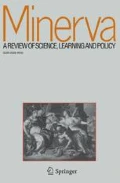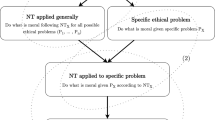Abstract
In the following pages we discuss three historical cases of moral economies in science: Drosophila genetics, late twentieth century American astronomy, and collaborations between American drug companies and medical scientists in the interwar years. An examination of the most striking differences and similarities between these examples, and the conflicts internal to them, reveals constitutive features of moral economies, and the ways in which they are formed, negotiated, and altered. We critically evaluate these three examples through the filters of rational choice, utility, and American pragmatism, using the latter to support the conclusion that there is no single vision of moral economies in science and no single theory—moral, political, social—that will explain them. These filters may not be the only means through which to evaluate the moral economies examined, but aspects of each appear prominent in all three cases. In addition, explanations for decisions are often given in the language of these theories, both at the macro (policy) level and at the local level of the moral economies we discuss. In light of such factors, the use of these frameworks seems justified. We begin with an attempt to define the nature of moral economies, then move to a consideration of scientific communities as moral communities operating within material and other constraints which we relate to wider questions of political economy and societal accountabilities.
Similar content being viewed by others
Notes
Merton argues that Science is an autonomous institution, separate from the wider society. Its status is guaranteed by adherence to four immutable norms of scientific inquiry, which require scientific knowledge to be: Communal—belonging to everyone and owned by no one; Universal rather than particularistic, in the creation and evaluation of knowledge; Disinterested—free of bias and self-interest, a status policed by the institution of peer review; and dependent on ‘Organized Skepticism—in that novel research claims are subject to detached and critical scrutiny. See Merton (1973); for counter norms see Ziman (1994).
California, Chicago, Harvard, Wisconsin, Michigan, Indiana and Ohio State.
UK, Canada, Australia, Chile, Brazil, Argentina. Capital costs were $184 million; annual operating costs are $20 million of which the partners pay half. See McCray (2000, p. 687).
“Drug houses” refers to pharmaceutical companies, while those fully listing ingredients and marketing through medical professionals are known as ethical houses.
We thank Minerva’s anonymous reviewers for pointing out this important distinction.
E.g. thinkers like John von Neumann, Oskar Morgenstern, Kenneth J. Arrow, and Mancur Olson.
We thank Minerva’s anonymous reviewers for their insightful comments and clarifications on this point.
The theoretical analysis here benefitted greatly from the comments of reviewers.
However, one can perform their ‘utilitarian calculus’ correctly and still end up with a morally undesirable outcome. Judged in utilitarian terms, the action is wrong, but moral blame may not accrue to the decision maker so long as the principle of utility was applied correctly given the information and opportunities available. So, correct moral thinking can lead to incorrect moral decisions.
Thank you to the Minerva reviewers for their helpful comments on the importance of locally formed epistemologies.
References
Allen, Garland E. 1978. Thomas Hunt Morgan: The man and his science. Princeton: Princeton University Press.
Amadae, Sonja M. 2003. Rationalizing capitalist democracy: The cold war origins of rational choice liberalism. Chicago: University of Chicago Press.
Atkinson-Grosjean, Janet. 2006. Public science, private interests: Culture and commerce in Canada’s networks of centres of excellence. Toronto: University of Toronto Press.
Atkinson-Grosjean, Janet. 1998. Illusions of excellence and the selling of the university: A micro-study. Electronic Journal of Sociology 3 (3).
Atkinson-Grosjean, Janet. 2002. Adventures in the nature of trade. PhD, University of British Columbia.
Daston, Lorraine. 1995. The moral economy of science. Osiris 10(Constructing knowledge in the history of science): 3–24.
Dewey, John. 1982. The practical character of reality. In Pragmatism: The classic writings, ed. H.S. Thayer, 275–279. Indianapolis: Hackett.
Hollinger, David A. 1990. Free enterprise and free inquiry: The emergence of laissez-faire communitarianism in the ideology of science in the United States. New Literary History 21(4, Papers from the Commonwealth Center for Literary and Cultural Change): 897–919.
Kohler, Robert E. 1994. Lords of the fly: Drosophila genetics and the experimental life. Chicago: University of Chicago Press.
Kohler, Robert E. 1999. Moral economy, material culture and community in drosophila genetics. In The science studies reader, ed. Mario Biagioli, 243–257. New York: Routledge.
Marks, Harry M. 1997. The progress of experiment: Science and therapeutic reform in the United States, 1900–1990. Cambridge/New York: Cambridge History of Medicine/Cambridge University Press.
McCray, Patrick W. 2000. Large telescopes and the moral economy of recent astronomy. Social Studies of Science 30 (5): 685–711.
Merton, Robert K. 1938. Science and the social order. Philosophy of Science 5 (3): 321–337.
Merton, Robert K. 1973. The normative structure of science. In The sociology of science: Theoretical and empirical investigations, ed. Norman W. Storer, 267–278. Chicago: The University of Chicago Press.
Purcell, Edward A. 1973. The crisis of democratic theory: Scientific naturalism & the problem of value. Lexington: University Press of Kentucky.
Rasmussen, Nicolas. 2004. The moral economy of the drug company-medical scientist collaboration in interwar America. Social Studies of Science 34(2, Intersections of Pharmaceutical Research and Marketing): 161–185.
Rasmussen, Nicolas. 2005. The drug industry and clinical research in interwar America. Bulletin of the History of Medicine 79: 50–80.
Rorty, Richard. 1991. Objectivity, relativism, and truth. Philosophical papers, vol. 1. Cambridge/New York: Cambridge University Press.
Scott, James C. 1976. The moral economy of the peasant: Rebellion and subsistence in Southeast Asia. New Haven: Yale University Press.
Sen, Amartya K. 1977. Rational fools: A critique of the behavioral foundations of economic theory. Philosophy and Public Affairs 6 (4): 317–344.
Tauber, Alfred I. 1999. Is biology a political science? BioScience 49 (6): 479–486.
Thompson, Edward P. 1993. The moral economy of the English crowd in the 18th century. In Customs in common: Studies in traditional popular culture, ed. E.P. Thompson, 185–258. New York: New Press/W.W. Norton.
Wang, Jessica. 2002. Scientists and the problem of the public in cold war America, 1945–1960. Osiris 17(Science and Civil Society): 323–347.
Ziman, J.M. 1994. Prometheus bound: Science in a dynamic steady state. Cambridge/New York: Cambridge University Press.
Acknowledgments
We gratefully acknowledge the support of Genome Canada through the Pathogenomics of Innate Immunity project. We also thank the journal’s anonymous reviewers for their insightful comments and recommendations.
Author information
Authors and Affiliations
Corresponding author
Rights and permissions
About this article
Cite this article
Atkinson-Grosjean, J., Fairley, C. Moral Economies in Science: From Ideal to Pragmatic. Minerva 47, 147–170 (2009). https://doi.org/10.1007/s11024-009-9121-7
Received:
Accepted:
Published:
Issue Date:
DOI: https://doi.org/10.1007/s11024-009-9121-7




